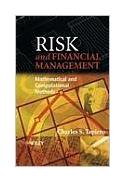|
||
podział tematyczny • wydawnictwa anglojęzyczne podział tematyczny Newsletter: • Zamów informacje o nowościach z wybranego tematu Informacje: • sposoby płatności i dostawy • kontakt • Cookies na stronie • Regulamin zakupów Napisz propresssp@gmail.com |
RISK AND FINANCIAL MANAGEMENTTAPIERO C.wydawnictwo: WILEY , rok wydania 2003, wydanie Icena netto:
Risk and Financial Management: Mathematical and Computational Methods is ideally suited to both students of mathematical finance with little background in economics and finance, and students of financial risk management, as well as finance practitioners requiring a clearer understanding of the mathematical and computational methods they use every day. It combines the required level of rigor, to support the theoretical developments, with a practical flavour through many examples and applications. Table of Contents Preface. Part I: Finance and Risk Management. Chapter 1: Potpourri. 1.1 Introduction. 1.2 Theoretical finance and decision making. 1.3 Insurance and actuarial science. 1.4 Uncertainty and risk in finance. 1.4.1 Foreign exchange risk. 1.4.2 Currency risk. 1.4.3 Credit risk. 1.4.4 Other risks. 1.5 Financial physics. Selected introductory reading. Chapter 2: Making Economic Decisions under Uncertainty. 2.1 Decision makers and rationality. 2.1.1 The principles of rationality and bounded rationality. 2.2 Bayes decision making. 2.2.1 Risk management. 2.3 Decision criteria. 2.3.1 The expected value (or Bayes) criterion. 2.3.2 Principle of (Laplace) insufficient reason. 2.3.3 The minimax (maximin) criterion. 2.3.4 The maximax (minimin) criterion. 2.3.5 The minimax regret or Savage's regret criterion. 2.4 Decision tables and scenario analysis. 2.4.1 The opportunity loss table. 2.5 EMV, EOL, EPPI, EVPI. 2.5.1 The deterministic analysis. 2.5.2 The probabilistic analysis. Selected references and readings. Chapter 3: Expected Utility. 3.1 The concept of utility. 3.1.1 Lotteries and utility functions. 3.2 Utility and risk behaviour. 3.2.1 Risk aversion. 3.2.2 Expected utility bounds. 3.2.3 Some utility functions. 3.2.4 Risk sharing. 3.3 Insurance, risk management and expected utility. 3.3.1 Insurance and premium payments. 3.4 Critiques of expected utility theory. 3.4.1 Bernoulli, Buffon, Cramer and Feller. 3.4.2 Allais Paradox. 3.5 Expected utility and finance. 3.5.1 Traditional valuation 3.5.2 Individual investment and consumption. 3.5.3 Investment and the CAPM. 3.5.4 Portfolio and utility maximization in practice. 3.5.5 Capital markets and the CAPM again. 3.5.6 Stochastic discount factor, assets pricing and the Euler equation. 3.6 Information asymmetry. 3.6.1 'The lemon phenomenon' or adverse selection. 3.6.2 'The moral hazard problem'. 3.6.3 Examples of moral hazard. 3.6.4 Signalling and screening. 3.6.5 The principal-agent problem. References and further reading. Chapter 4: Probability and Finance. 4.1 Introduction. 4.2 Uncertainty, games of chance and martingales. 4.3 Uncertainty, random walks and stochastic processes. 4.3.1 The random walk. 4.3.2 Properties of stochastic processes. 4.4 Stochastic calculus. 4.4.1 Ito's Lemma. 4.5 Applications of Ito's Lemma. 4.5.1 Applications. 4.5.2 Time discretization of continuous-time finance models. 4.5.3 The Girsanov Theorem and martingales*. References and further reading. Chapter 5: Derivatives Finance. 5.1 Equilibrium valuation and rational expectations. 5.2 Financial instruments. 5.2.1 Forward and futures contracts. 5.2.2 Options. 5.3 Hedging and institutions. 5.3.1 Hedging and hedge funds. 5.3.2 Other hedge funds and investment strategies. 5.3.3 Investor protection rules. References and additional reading. Part II: Mathematical and Computational Finance. Chapter 6: Options and Derivatives Finance Mathematics. 6.1 Introduction to call options valuation. 6.1.1 Option valuation and rational expectations. 6.1.2 Risk-neutral pricing. 6.1.3 Multiple periods with binomial trees. 6.2 Forward and futures contracts. 6.3 Risk-neutral probabilities again. 6.3.1 Rational expectations and optimal forecasts. 6.4 The Black-Scholes options formula. 6.4.1 Options, their sensitivity and hedging parameters. 6.4.2 Option bounds and put-call parity. 6.4.3 American put options. References and additional reading. Chapter 7: Options and Practice. 7.1 Introduction. 7.2 Packaged options. 7.3 Compound options and stock options. 7.3.1 Warrants. 7.3.2 Other options. 7.4 Options and practice. 7.4.1 Plain vanilla strategies. 7.4.2 Covered call strategies: selling a call and a share. 7.4.3 Put and protective put strategies: buying a put and a stock. 7.4.4 Spread strategies. 7.4.5 Straddle and strangle strategies. 7.4.6 Strip and strap strategies. 7.4.7 Butterfly and condor spread strategies. 7.4.8 Dynamic strategies and the Greeks. 7.5 Stopping time strategies*. 7.5.1 Stopping time sell and buy strategies. 7.6 Specific application areas. 7.7 Option misses. References and additional reading. Appendix: First passage time*. Chapter 8: Fixed Income, Bonds and Interest Rates. 8.1 Bonds and yield curve mathematics. 8.1.1 The zero-coupon, default-free bond. 8.1.2 Coupon-bearing bonds. 8.1.3 Net present values (NPV). 8.1.4 Duration and convexity. 8.2 Bonds and forward rates. 8.3 Default bonds and risky debt. 8.4 Rated bonds and default. 8.4.1 A Markov chain and rating. 8.4.2 Bond sensitivity to rates - duration. 8.4.3 Pricing rated bonds and the term structure risk-free rates*. 8.4.4 Valuation of default-prone rated bonds*. 8.5 Interest-rate processes, yields and bond valuation*. 8.5.1 The Vasicek interest-rate model. 8.5.2 Stochastic volatility interest-rate models. 8.5.3 Term structure and interest rates. 8.6 Options on bonds*. 8.6.1 Convertible bonds. 8.6.2 Caps, floors, collars and range notes. 8.6.3 Swaps. References and additional reading. Mathematical appendix. A.1: Term structure and interest rates. A.2: Options on bonds. Chapter 9: Incomplete Markets and Stochastic Volatility. 9.1 Volatility defined. 9.2 Memory and volatility. 9.3 Volatility, equilibrium and incomplete markets. 9.3.1 Incomplete markets. 9.4 Process variance and volatility. 9.5 Implicit volatility and the volatility smile. 9.6 Stochastic volatility models. 9.6.1 Stochastic volatility binomial models*. 9.6.2 Continuous-time volatility models. 9.7 Equilibrium, SDF and the Euler equations*. 9.8 Selected Topics*. 9.8.1 The Hull and White model and stochastic volatility. 9.8.2 Options and jump processes. 9.9 The range process and volatility. References and additional reading. Appendix: Development for the Hull and White model (1987)*. Chapter 10: Value at Risk and Risk Management. 10.1 Introduction. 10.2 VaR definitions and applications. 10.3 VaR statistics. 10.3.1 The historical VaR approach. 10.3.2 The analytic variance-covariance approach. 10.3.3 VaR and extreme statistics. 10.3.4 Copulae and portfolio VaR measurement. 10.3.5 Multivariate risk functions and the principle of maximum entropy. 10.3.6 Monte Carlo simulation and VaR. 10.4 VaR efficiency. 10.4.1 VaR and portfolio risk efficiency with normal returns. 10.4.2 VaR and regret. References and additional reading. Author Index. Subject Index. 338 pages Księgarnia nie działa. Nie odpowiadamy na pytania i nie realizujemy zamówien. Do odwolania !. |


